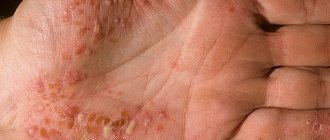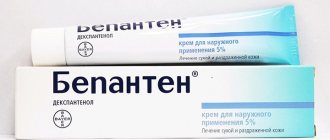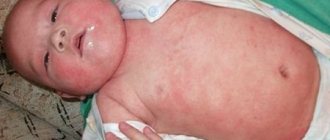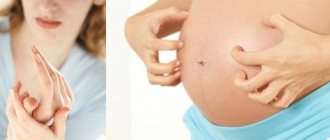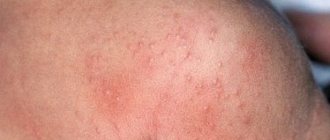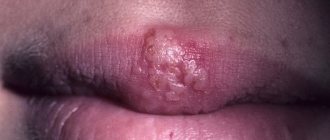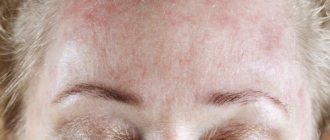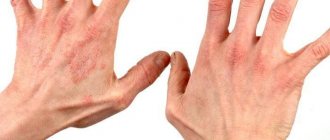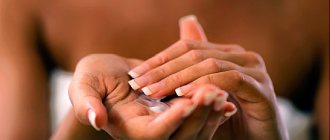Why is it necessary to adjust your diet?
Nutrition for dermatitis is important.
By correcting the diet, the cause of this disease can be determined. At the beginning of the diet, all possible allergens are excluded. After this, they switch to a therapeutic diet, which begins with a short fast. At this time, you can only drink clean water. Then the diet is slowly expanded.
This approach is necessary to identify the provoking factor. If after consuming a product there is an exacerbation of dermatitis, then it is excluded from the patient’s menu forever.
Food in this disease must be well digested, so it is necessary to avoid eating too heavy meals.
The main task of such nutrition is to cleanse the body's systems of accumulated toxins and switch to a diet with a minimum amount of allergens.
What is perioral dermatitis
Perioral dermatitis is a pathological condition in which papules or pustules appear in the mouth and chin in the form of pink spots and pimples. The disease is chronic. Therefore, having acquired this type of dermatitis, you should prepare for subsequent relapses.
Perioral dermatitis is a fairly rare disease that mainly affects the female population under 40 years of age.
Etiology
The cause of oral dermatitis is unknown. There are a number of factors that can trigger the development of the disease:
- cosmetics and sunscreens (especially with a high degree of SPF), which have a pronounced occlusive ability;
- exposure to ultraviolet radiation, which causes active sweating and disruption of the skin barrier function;
- use of external, intranasal, inhaled glucocorticosteroids;
- bacterial and fungal infection;
- use of fluoride toothpastes.
The pathology occurs mainly in adolescent children prone to allergic reactions, suffering from bronchial asthma, atopic dermatitis, neurodermatitis, and in the presence of hormonal imbalance.
Possible complications
Perioral dermatitis is characterized by a relapsing course, and with relapses of the disease, more intense rashes and painful sensations accompanying the appearance of the rash may be observed.
If perioral dermatitis is not adequately treated, pigment spots and scars may remain on the skin.
Cosmetic problems and discomfort experienced by patients with perioral dermatitis can lead to psychological problems, neuroses, and depression.
Exacerbation of perioral dermatitis can lead to stress and neuroses due to physical and aesthetic discomfort. If the rash is damaged, there is a danger of infection entering the body. Also, after the rash disappears, scars may remain.
Aesthetic problems and discomfort that arise with the development of perioral dermatitis can provoke various psychological problems, cause depression or neuroses. This is a chronic disease, so relapses may be accompanied by more severe symptoms (discomfort and skin rashes).
Complications of perioral dermatitis
Incorrect or untimely treatment can cause acne scars or pigment spots to appear on the skin. In addition, the affected areas of the skin become drier, pale and tight.
The disease, with a long, long-term course with severe exacerbations, can lead to:
- pigment spots on the face - can only be eliminated by laser surgery;
- scars - traces of resolved large ulcers;
- chronic increased background of pathogenic microflora in the skin.
The most dangerous complication is the appearance of pathological skin cells, because With chronic inflammation, constant accelerated cell division occurs. What can cause the appearance of cells with damaged DNA.
Reasons for appearance
The causes of perioral dermatitis, also called perioral rosacea, are still unknown. However, there are known risk factors that, taken together, can lead to oral dermatitis:
- the use of creams and ointments containing steroid hormones, for example, Prednisolone. This reason leads to the appearance of a rash most often, so long-term use of this group of products is considered one of the diagnostic signs;
- the use of decorative cosmetics (foundation, makeup base or lipstick) that contain potential allergens. Due to the fact that cosmetics play a significant role in the pathogenesis of the disease, perioral dermatitis, a photo of which you can see below, is sometimes called “stewardess disease”;
- negative impact of natural factors (high air humidity, frost or excessive insolation). The disease may appear after moving to another climate zone or during a sudden change in weather;
- perioral rosacea is often observed in patients suffering from disorders of the gastrointestinal tract, for example, prolonged constipation, dysbacteriosis, gastric and duodenal ulcers;
- Often the main cause of the development of the disease is microorganisms that live in the hair follicles. These can be fungi or bacteria, which are often detected when analyzing bacteriological culture data of the contents of the rash. However, specific microorganisms that cause dermatitis could not be detected;
- Perioral rosacea worsens during periods of stress or after severe emotional shocks. Most likely, this is due to disturbances in the neurohumoral regulation of the body;
- the use of low-quality toothpastes containing fluoride leads to the appearance of a rash;
- The state of the endocrine system plays a significant role in the occurrence of a rash. Oral dermatitis in women often occurs during premenstrual syndrome, while taking oral contraceptives or with hormonal disorders.
Cosmetics play a major role in the occurrence of perioral dermatitis. The following are considered especially “dangerous”:
- products with cinnamon scent;
- cosmetics based on petroleum jelly and paraffin;
- products containing sodium lauryl sulfate.
Most often, women under the age of 40 suffer from a rash around the mouth. In men, perioral rosacea develops in rare cases.
Diet
A special diet is the most important part of the treatment of perioral dermatitis.
The daily menu should include:
- light soups;
- fermented milk products;
- porridge;
- steamed vegetables;
- fresh vegetable salads;
- dried bread;
- cheese;
- pasta;
- fresh berry compotes;
- poultry and river fish in boiled form.
The following foods should be excluded from the diet:
- sweets;
- alcoholic drinks;
- caffeinated drinks;
- citrus;
- sea fish;
- fat meat;
- eggs;
- soy;
- mushrooms;
- fried, pickled, smoked dishes.
Breakfast: fresh vegetable salad, 1 glass of compote.
Lunch: light soup with a slice of dried bread, steamed fish or meat cutlet, 1 glass of kefir.
Afternoon snack: green apple with 1 glass of compote or jelly.
Dinner: pasta with boiled chicken breast, 1 glass of kefir.
Be sure to read:
Tips on how to treat heat rash in a newborn
nginx
For perioral dermatitis, patients are advised to adhere to a hypoallergenic (mainly plant-based) diet. In the absence of a therapeutic effect, the diet can be replaced by therapeutic fasting according to an individually selected scheme.
It is recommended to include cereals, legumes, lean meat (boiled in water or steamed), fermented milk products, wholemeal bread, green vegetables and fruits in the diet. You should avoid drinking tea, coffee, alcoholic beverages, citrus fruits, eggs, mushrooms, fish, sausage products, canned food, yeast dough products, spices, and limit the consumption of salt and sugar. To normalize metabolism, patients need plenty of fluids.
In some cases, bowel cleansing through enterosorbents and therapeutic enemas is required.
For perioral dermatitis, a hypoallergenic diet and plenty of fluids are recommended.
Diet for perioral dermatitis is a purely individual issue. Everything is determined by whether the body reacts with a cascading allergic reaction to a particular product.
Typically, patients themselves quickly determine which foods should be avoided for their own good, and which should be excluded.
In food, the following are traditionally considered allergenic:
- citrus;
- nuts;
- honey;
- chicken meat;
- mushrooms;
- chocolate (cocoa);
- pineapples;
- most berries;
- tomatoes;
- red fish.
Patients with perioral dermatitis are usually prescribed a special hypoallergenic diet. In the case where it does not have a positive effect, or in case of severe development of the disease, the diet can be replaced by short-term therapeutic fasting in accordance with the individual scheme.
| AUTHORIZED PRODUCTS | PROHIBITED PRODUCTS |
| wholemeal bread | eggs, mushrooms |
| fermented milk products | fish, caviar, fish and sausage products |
| cereals | tea and coffee |
| legumes | alcohol |
| green vegetables and fruits | citruses, carrots |
| lean meat (boiled, in a steam bath) | the diet excludes various spices and carbohydrates |
In addition, the diet for perioral dermatitis recommends limiting salt and sugar intake.
It must be remembered that it is recommended to drink at least 2 liters of liquid per day, which allows for proper metabolism in the body and normalizes the flow of necessary microelements into the tissues and performs cryomassage.
If atopic or seborrheic dermatitis appears in an infant, then the mother should follow the diet, since allergens enter the child’s body with milk. It is necessary to exclude from the diet fatty dairy products, fatty meat broths, butter, lard, as well as allergenic foods. Food should be easy for the baby's body to digest.
The diet should be balanced and varied so that the baby receives all the necessary nutrients. A diet for dermatitis for pregnant and nursing mothers involves consuming the following foods:
- white sea fish;
- lean meats;
- vegetables, fruits and berries that are not red;
- greens (dill, onion, parsley);
- porridge, preferably buckwheat, pearl barley, oatmeal and rice;
- low-fat fermented milk products without additives, as well as cottage cheese and hard cheese;
- bread;
- green and weak black tea;
- dried fruits compote;
- berry juice.
How to cure disease in women during pregnancy and lactation
When the disease worsens, women who are breastfeeding are concerned about the question: is this type of dermatitis contagious or not, is it transmitted by airborne droplets, and what should be done to prevent the baby from having problems similar to the mother’s.
In fact, there is no danger of infection, doctors assure. However, a predisposition to such a disease can be transmitted at the genetic level, and nothing can be done about it.
The only thing a woman needs to do in this situation is to take care of the child’s hygiene, teach him to do this on his own in the future, and to use detergents and cosmetics correctly.
In pregnant women, perioral dermatitis sometimes appears at the beginning of pregnancy, this is due to physiological changes in the body and weakened immunity.
Drug therapy for expectant mothers must be selected by a doctor, since many drugs that a woman has successfully used before are contraindicated in her new condition.
By the way, even such a harmless product, in the opinion of many women, as boric acid cannot be used either during pregnancy or while breastfeeding - it is quickly absorbed from the surface of the skin into the depths, enters the blood and can negatively affect the developing fetus.
Features of the disease in childhood
Manifestations of the disease in children have their own characteristics. Before puberty, most often the rashes differ little in color from the skin. They are usually flesh-colored, but may be slightly pink. There are almost no other symptoms; sometimes the child may complain of a burning sensation in the affected areas of the skin.
The rash can be single or form clusters in the form of spots. Not only the area around the mouth can be affected, but also near the ears, eyes, skin on the head, hands, and genital area.
With the onset of puberty, the manifestations of the disease are practically no different from those in an adult.
How to cure disease in women during pregnancy and lactation
The treatment regimen should be determined by the triggering factors of the disease. For example, if dermatitis was caused by GCS drugs, then hormonal ointments are unacceptable. With other options, their limited use can quickly relieve inflammation.
It is not yet possible to cure this disease 100% and completely. Even after a therapeutic course, an exacerbation may occur again after some time.
Treatment of perioral dermatitis on the skin of the face begins with the exclusion of all aggressive factors:
- harsh cleansers;
- flashy cosmetics, etc.
The effectiveness of therapy will increase many times if you create an overall favorable background for the skin.
A protective external hypoallergenic agent is well suited against external agents (ultraviolet, frost, wind).
For example:
- La Roche Posay Toleriane Riche;
- products from Siberica.
Drug treatment includes the use of:
- ointments;
- creams and gels;
- antibiotics and antibacterial drugs;
- antimicrobial agents;
- hormonal drugs.
The use of ointments provides the main local therapy, which allows you to quickly remove the most unpleasant symptoms for the patient.
The first task that is set for regional drugs is to block the inflammatory process in the dermis.
Examples of suitable means:
- Elidel (Pimecrolimus) - this cream inhibits the functioning of T-lymphocytes, thereby blocking the synthesis of cytokines that trigger inflammation;
- Zinc paste is a cheap analogue; zinc has antimicrobial, anti-inflammatory and protective effects.
Antibiotics and antibacterial drugs are often used for this dermatitis, due to the high probability of secondary infection.
Among antibiotics, doctors prefer the tetracycline series:
- Tetracycline;
- Oxytetracycline.
Along with the antibiotic, the antiprotozoal and antimicrobial agent Metronidazole and preparations containing it are used:
- Trichopolum (tablet form);
- Rosamet cream.
The mechanism of action of Metronidazole is to block the process of bacterial DNA replication, which leads to the death of the colony. Metronidazole exhibits synergy with most antibiotics, i.e. a mutually reinforcing effect is observed.
Since the development of perioral dermatitis is closely related to allergic mechanisms, antihistamines are prescribed simultaneously with antibiotics, or as an alternative:
- 1st generation - Suprastin (Chloropyramine), Clemastine, Diphenhydramine, competitively bind to histamine receptors, but the risk of biochemical adaptation is high, plus there are frequent side effects (mainly drowsiness and headache);
- 2nd generation - the gold standard here is Loratadine, but there is also Ebastine, Cetirizine, etc., they block histamine receptors much faster, there is less chance of adaptation and side effects are minimized;
- 3rd generation - Erius (Desloratadine), in addition to the above, Erius is able to suppress the synthesis of histamine itself.
Hormonal ointment treatment option:
- Akriderm;
- Triderm;
- Hydrocortisone;
- Sinaflan.
Recommended only in consultation with a dermatologist.
The problem is that withdrawal symptoms are very common among patients. At first, hormonal ointments help very well, but when the course is stopped, the disease returns with triple force.
Folk recipes
Perioral dermatitis, with mild exacerbation, can be extinguished at home using folk recipes.
Examples:
- Japanese Sophora: • 2 tbsp. spoons of grated fruit are brewed with boiling water (200 ml), left overnight, and drunk in the morning; • either 2 tbsp. spoons are filled with high-quality vodka (0.5 liters), infused for 10 days in a dark place. The tincture is rubbed into the affected areas.
- Honey and fresh Kalanchoe juice: • mix in equal parts and leave for a week in a dark place, then add the same amount of Kalanchoe juice and leave again for a week. • the mixture can be rubbed into sore skin.
- Fresh St. John's wort juice: • evaporate to half the original volume, add butter (1:4) - the mixture for rubbing is ready.
- Fresh celery: • grind into a paste, add a few ml of vinegar essence and a pinch of table salt - the lotion is ready.
Before turning to traditional medicine, you should still consult a doctor.
During pregnancy
Perioral dermatitis during pregnancy proceeds similarly.
The only problem is that pregnant women, especially in the 1st trimester, are incredibly sensitive to the toxic effects of antibiotics.
And later, the baby’s body inevitably comes into contact with the antibiotic through the hematoplacental barrier. This creates difficulties when prescribing antibacterial agents.
Macrolides can serve as a milder analogue:
- Josamycin;
- Roxithromycin.
Treatment methods
When the diagnosis is confirmed, it is first necessary to stop taking medications that contain corticosteroids. In addition, you should avoid using decorative cosmetics and toothpaste containing fluoride. During treatment, it is recommended to avoid exposing the skin to direct sunlight and use sunscreen in the summer.
Treatment of perioral dermatitis is medicinal. If itching is present, antihistamines are indicated, and sedatives may also be required. In case of pronounced swelling, diuretic drugs may be prescribed. When a bacterial infection occurs, local or systemic antibiotics are used. Taking vitamin complexes and immunomodulators is indicated.
For local treatment of perioral dermatitis, medications with a cooling effect in the form of a cream are used, as well as infusions of medicinal plants (calendula, chamomile, celandine, St. John's wort, etc.), lotions from a solution of boric acid.
Treatment of perioral dermatitis with medication using sedatives, antihistamines, antibacterial agents, immunomodulators
Treatment of perioral dermatitis lasts from several weeks to several months, depending on the severity of the pathological process. Since the disease is prone to recurrence (especially with the use of cosmetics, decreased immunity and changes in climatic conditions), patients are advised to follow preventive measures.
Therapy for perioral dermatitis requires a lot of patience, since the disease brings significant discomfort from an aesthetic point of view and takes a very long time to heal.
To treat perioral dermatitis in adults and children, anti-inflammatory and drying local drugs are used, such as:
- Protopic ointment (immunosuppressant). Apply to affected areas 2 times a day.
- Elidel cream (anti-inflammatory). Treat skin 2 times a day.
- Gel Metrogyl (antibacterial external agent). Apply to problem areas 2 times a day until the rash disappears completely. Usually the course of treatment takes up to 2 months.
Photo of perioral dermatitis on a woman’s face.
The following medications can alleviate the condition:
- Loratadine. Histamine H1 receptor blocker. Has antiallergic, antipruritic, antiexudative effects. Take 1 tablet per day 10-15 minutes before meals. On average, the course of treatment takes about 1 month.
- Suprastin. Histamine H1 receptor blocker. Antiallergic drug. 1 tablet 3 times a day. The duration of treatment is determined by the attending physician.
- Doxycycline. Semi-synthetic antibiotic of the tetracycline group with a broad spectrum of action. 1 tablet 2 times a day until signs of the disease completely disappear. After this, you should take 1 tablet once a day for 1 month.
Folk remedies
Together with medications, it is useful to use folk remedies in the treatment of perioral dermatitis. The most effective recipes are:
- Aloe juice. Fresh aloe stalk needs to be crushed to a paste consistency. Squeeze out the juice with gauze. Add honey and medical alcohol (all ingredients should be in equal proportions). Wipe the affected areas of the skin with the prepared product 2 times a day.
- Propolis. You need to mix propolis with any vegetable oil in a ratio of 1:4. Heat until the propolis is completely dissolved, cool. Apply to problem skin 3 times a day.
- Chamomile and calendula. Take 1 tablespoon each of dried calendula and chamomile flowers and pour 2 cups of boiling water. Leave to infuse for 1 hour, then strain. Take clean gauze and soak it in the prepared infusion. Apply to face as a compress and keep for 15 minutes.
- Birch buds. You will need to take 1 tablespoon of birch buds, pour 1 cup of boiling water over the raw material. Leave for 1 hour, then filter. Wipe the affected areas on the face with the prepared infusion before applying medicinal ointment or cream.
Note! Regular use of traditional medicine gives good results, but they must be used in combination with medications. They are not suitable as an independent treatment method.
To rid a child of perioral dermatitis, the following measures are required:
- Completely stop using cosmetics and chemicals. These can be bath cleansers, conditioners, powders, fluoride toothpastes, shampoos, creams.
- Provide your baby with a hypoallergenic environment. You need to wipe off dust every day, do wet cleaning, ventilate the children's room, remove all soft toys, and try to limit contact with pets.
- Review your diet. Exclude citrus fruits, red fruits, chocolate, sweets, and, if possible, dairy products from your daily menu.
Be sure to read:
Scleroderma: what kind of disease is it and how is it life-threatening?
Direct treatment should include:
- Taking antihistamines to relieve itching and redness.
- In advanced forms of dermatitis, oral antibiotics are prescribed.
- Ointments with high zinc content.
It is important to know! In the treatment of perioral dermatitis in childhood, hormonal drugs are not used.
During pregnancy, this form of dermatitis usually occurs in the first trimester. Treatment in this case is difficult, since most drugs are contraindicated when carrying a child. It is necessary to select harmless external remedies and physiotherapeutic procedures. In addition, you must follow a diet, limit your time in the sun, and stop using cosmetics.
Treatment of dermatitis is complex, so not only medications are prescribed, but also a diet.
The treatment regimen for perioral dermatitis is quite complex. To cure the patient, the doctor uses many different medications and recommends dietary nutrition. Compliance with all the doctor’s instructions is the key to victory over the disease.
The doctor begins treatment by canceling all hormonal drugs that the patient was using (this could be, for example, Advantan, Akriderm, Elokom).
The doctor also establishes a ban on the use of cosmetics. Washing in the traditional way is also prohibited.
If the disease is not very advanced, water can be replaced by rubbing with decoctions of medicinal herbs (sage and chamomile). In difficult situations, use special emulsions prepared on the basis of oil.
Medicines usually include a cream, ointment or gel, the main active ingredients of which are Metronidazole (Trichopol) and Erythromycin (erythromycin ointment is a proven drug, known to many patients, and has a reputation as one of the safest antibiotics).
Here is a list of medications used:
- Tetracycline is an antibiotic prescribed for severe forms of dermatitis;
- Tetracycline ointment – with an active antimicrobial effect;
- Unidox Solutab is an antibiotic of the tetracycline group, used to treat skin infections;
- Azithromycin is an antibiotic used to treat skin infections;
- Polysorb – as an absorbent;
- Cynovit – as an antifungal agent;
- Protopic - successfully relieves inflammation, however, the drug should not be used by breastfeeding and pregnant women due to possible side effects;
- Skinoren, Azelik - prescribed for intolerance to Metronidazole;
- Skin cap and other products containing zinc (among the most popular are zinc mash, zinc ointment) dry the skin well and can relieve itching;
- Elidel – relieves inflammation, can be successfully combined with other drugs used in complex therapy, and is approved for children from three months of age;
- Radevit ointment – effective for epithelial regeneration;
- Rozamet is a soft and at the same time effective preparation that, if necessary, can be used as a base for makeup;
- Metrogyl gel – has an antibacterial effect;
- Isotrethionine – with a similar effect to Metrogyl;
- Retinoic ointment (with isotretinoin as the main component) - helps in tissue regeneration;
- Yam ointment – stops the inflammatory process;
- Bepanten – improves the regeneration of damaged skin.
At the final stage of treatment of perioral dermatitis, various physiotherapy procedures are actively used. Cryomassage using liquid nitrogen or snow is considered an effective remedy.
If necessary, the doctor prescribes sedative medications.
Vitamin therapy is mandatory, especially for children. Thanks to it, the protective functions of the body as a whole and specifically the skin are increased.
But you need to be careful with microelements; some of them (they are called “reactogenic”) sometimes worsen the condition of the skin.
In this regard, doctors limit the intake of iron and copper in certain medications for patients with dermatitis.
Many patients are helped by folk remedies. True, here you need to choose “your” option, since the effectiveness in each case depends on the characteristics of the skin of a particular person.
What we can recommend:
- lotion made from flaxseed oil, honey and onion juice (prepared in a water bath);
- lotions from oak bark decoction;
- infusion of birch buds (taken orally, a teaspoon of plant material is required per glass of water);
- infusion of walnut leaves (prepared in a thermos, used as lotions);
- pumpkin masks (grated and applied to inflamed skin);
- infusion of sorrel leaves (take 4 times a day, half a glass).
The diet for a patient with dermatitis should include foods rich in protein and calcium. Be sure to drink plenty of fluids.
For first courses, give preference to vegetable soups, fish soup, and cook lean borscht. There must be fermented milk products, cereals, fruits, and vegetables on the table.
Here's what one day's menu might look like:
- Breakfast: fish with corn porridge, steamed (for example, in a slow cooker), tea.
- Lunch: cream soup of fresh zucchini, salad of leafy vegetables, buckwheat porridge, dried fruit compote.
- Afternoon snack: kefir, cheese and a slice of dried bread.
- Dinner: cottage cheese seasoned with low-fat sour cream, tea.
Diagnostics
The diagnosis is made based on:
- medical history;
- laboratory tests;
- bacterial sowing.
Differentiation
Visual features:
- symmetrical arrangement of rashes;
- rash colonies may form;
- Typical site of injury:
- chin;
- nasolabial folds;
- skin around lips.
Symptoms are similar to diseases such as:
- allergic dermatitis;
- steroid and rosacea;
- diffuse neurodermatitis.
If you experience any of these symptoms, you most likely have oral dermatitis on your face.
Find out what acute rhinosinusitis is. What does hemorrhagic diathesis look like? The answer is here.
Use of medications
To make an accurate diagnosis, you need to go to the clinic and undergo the necessary tests. Only the attending physician can recommend one way or another to combat the disease. Before using medications, it is advisable to follow simple rules: limit water treatments on the irritated area and stop using any cosmetics and hormonal ointments. Treatment should be comprehensive and consist of the following:
- Complete nutrition.
- The use of local drugs and ointments, the main active ingredient in which is Metronidazole.
- Therapy with antibiotics, the most effective of which is Metronidazole. The pills are taken over several weeks.
- To reduce swelling of the face, antihistamines are prescribed, this may be Suprastin.
- If the affected areas become infected, they must be treated with antiseptics (Dekasan, Chlorhexidine).
- Taking vitamin and mineral complexes, folic acid to maintain immunity and skin regeneration. Sometimes doctors recommend removing toxins from the body with the help of enterosorbents.
- With prolonged stress, the use of sedatives will become relevant.
- In particularly advanced cases, it is possible to use cryomassage and reflexology.
You must strictly adhere to all the doctor’s recommendations and prepare for long-term treatment.
Metronidazole is an effective antibiotic
Prevention
The following preventive measures help prevent the development of pathology:
- refusal to use corticosteroid drugs, especially for the face;
- moderate use of decorative cosmetics;
- refusal to use low-quality cosmetics;
- timely treatment of gastrointestinal pathologies;
- replacing fluoride-containing toothpastes for oral hygiene with regular toothpastes;
- giving up harmful addictions;
- maintaining proper nutrition.
Perioral dermatitis is a pathology that does not threaten the patient’s health, but causes discomfort and aesthetic inconvenience. For this reason, therapy should not be delayed and if symptoms are detected, you should immediately contact a dermatologist.

